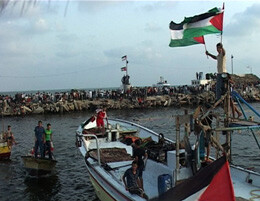The Electronic Intifada 4 January 2010

A scene from To Gaza with Love.
The Free Gaza Movement is a group of activists from around the world who decided to sail to Gaza from Cyprus to break the Israeli-enforced siege. The idea came about in response to Israel’s claim that, since the 2005 “disengagement,” it no longer occupies the coastal strip. Despite withdrawing its settlers, Israel still remains in control of all the borders, airspace and coast. The Free Gaza Movement is an effort to call Israel’s bluff. If Israel no longer occupies Gaza, it could surely have no objection to civilian boats sailing in — or so the argument went.
Although it is independent of the International Solidarity Movement (ISM), many in the Free Gaza Movement are or have been ISM members, including ISM founder Huwaida Arraf. Israel has banned some of the members from entering Palestine/Israel.
The small group purchased two second-hand boats in Cyprus, and the film recounts the trials and tribulations they went through in the course of preparing to embark on the sea journey.
At the time, many in the global Palestine solidarity movement were skeptical of the chances of success — but were happy to be proven wrong when the two small vessels eventually landed in Gaza. After watching this film, it becomes apparent this success was a near miracle.
It took about a week of false starts before the crew could even embark on the 30-hour sea journey. Beset by a number of logistical problems, the boats very nearly stayed in Cyprus. One of the vessels needed so many replacement parts that it would probably have been cheaper to buy a new boat. There were several changes of captain. And, as Ridley puts it, “consensus raised its ugly head” — referring to the often long-winded consensus decision making process used by the activist group.
Clashing egos, cabin fever and seasickness at times led to tensions within the group. Personalities like Ken O’Keefe (he of the 2002 human shields to Iraq group), Paul Larudee and Jeff Halper certainly make for an interesting cast of characters familiar within the Palestine solidarity movement. Nawaz does not shy away from showing the tensions and disagreements onboard. Ridley also criticizes the “anarchists and communists” (an oversimplified characterization of the group) for their indecision.
Media context is missing from this film. As narrator, Nawaz says the boats had been “a battle for world public opinion” — yet we see none of the coverage itself. Analysis of the media and some TV news clips would have added a lot to this film. At the very least the filmmakers could have shown screen-grabs from newspaper websites.
The narrator incorrectly includes James Miller in a list of “global activists” murdered by Israel along with ISMers Tom Hurndall and Rachel Corrie. Miller was in fact a cameraman, and was not part of any activist group. Death in Gaza, the film Miller was making when he was shot to death by an Israeli tank, ended up reserving most of its criticism for the Palestinians rather than Israel (it was finished after Miller’s death).
This first successful trip set a precedent, and four additional boat trips between October and December 2008 succeeded in landing on the shores of Gaza. It seemed for a while that Israel did not quite know what to do with the activists. Some who arrived on these boats stayed on in Gaza as ISM activists or worked with other organizations. Many stayed through the whole of Israel’s invasion of Gaza last winter. They did important work including documenting Israel’s war crimes against the civilian population of Gaza and medical and emergency workers and personnel.
Israeli ships took advantage of the fog of war and rammed the sixth Free Gaza boat on 29 December (only two days into the invasion). Since then it seems the siege-breaking tactic has itself been broken. Each subsequent boat trip has either been forced back, or, in the case of the last trip in June, had their crews kidnapped and forced into Israel (later expelled to their countries of origin). The narrative of this film ends after the first trip, but a brief summation of these later events would have been useful.
Despite these quibbles, this film is a unique account of an important and historic achievement. It is a useful resource for solidarity activists thinking about strategies on how to break the siege of Gaza, and how to express practical solidarity with Palestine.
Asa Winstanley is a freelance journalist who has lived in and reported from occupied Ramallah, working for the Palestine Times and the Jerusalem Media and Communications Centre. His website is www.winstanleys.org.
Related Links




